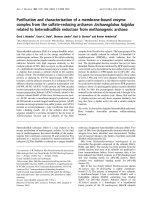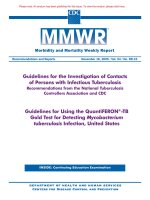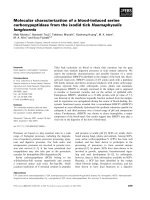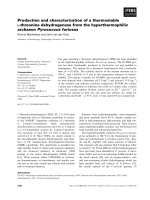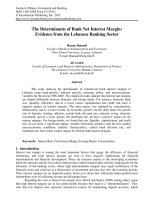Non invasive prenatal testing of haemoglobin barts using fetal DNA from the maternal plasma
Bạn đang xem bản rút gọn của tài liệu. Xem và tải ngay bản đầy đủ của tài liệu tại đây (4.55 MB, 232 trang )
NON-INVASIVE PRENATAL TESTING OF
HAEMOGLOBIN BART’S USING FETAL DNA FROM
THE MATERNAL PLASMA
SHERRY HO SZE YEE
NATIONAL UNIVERSITY OF SINGAPORE
2008
NON-INVASIVE PRENATAL TESTING OF
HAEMOGLOBIN BART’S USING FETAL DNA FROM
THE MATERNAL PLASMA
SHERRY HO SZE YEE
A THESIS SUBMITTED FOR THE DEGREE OF
DOCTOR OF PHILOSOPHY
DEPARTMENT OF OBSTETRICS AND
GYNAECOLOGY
NATIONAL UNIVERSITY OF SINGAPORE
2008
ACKNOWLEDGEMENTS
I undertook this work at the Department of Obstetrics and Gynaecology, Yong
Loo Lin School of Medicine, National University of Singapore. Firstly, I would
like to thank my supervisors, A/P Mahesh Choolani, A/P Arijit Biswas and Dr
Khalil Razvi for their constant support and scientific guidance. I would also
like to thank A/P Sinuhe Hahn (University of Basel, Switzerland), Jacquie
Keer (LGC Ltd, UK) and their team members for their friendship and guidance
in the initial part of this project. I would also like to extend my gratitude
towards A/P Evelyn Koay (Molecular Diagnosis Centre, NUH), A/P Samuel
Chong (Department of Paediatrics, NUS) and Dr Jerry Chan for their
invaluable advice. It has been a great pleasure working with our post-doctoral
fellows, Dr Sukumar Ponnusamy and Dr Narasimhan Kothandaraman. My
special thanks to my team members, Dr Nuruddin Binte Mohammed, Dr Qin
Yan, Zhang Huoming, Zhao Changqing, Fan Yiping, Dr Sonia Baig, Ho Lai
Meng and Tan Lay Geok who had made research enjoyable. I am most
grateful to all laboratory, administrative, clinical and nursing staff who had
been enthusiastic in the recruitment of patients, and patients who participated
in this study.
I would like to thank my family: my parents, especially my mother, Gek Khim,
for her constant faith in me, and my siblings for their love and encouragement.
Finally, I would like to thank my husband, Dennis Chong, for always being
there for me, and most of all, God, for making all this possible.
i
TABLE OF CONTENTS
ACKNOWLEDGEMENTS i
TABLE OF CONTENTS ii
SUMMARY v
LIST OF TABLES vii
LIST OF FIGURES viii
LIST OF ABBREVIATIONS xi
Units/ Symbols xiii
CHAPTER 1: INTRODUCTION 1
1.1 Background 1
1.2 Prenatal testing 4
1.2.1 Prenatal screening 5
1.2.1.1 Screening for chromosomal disorders 5
1.2.1.2 Screening for single gene disorders 7
1.2.2 Prenatal diagnosis
7
1.2.2.1 8
Invasive procedures of prenatal diagnosis
and their risks
1.2.2.2 Laboratory analysis of fetal material 10
1.3 Non-invasive prenatal diagnosis 12
1.3.1 Fetal cells in maternal blood 13
1.3.2 Fetal RNA in maternal blood 16
1.3.3 Fetal DNA in maternal blood 17
1.3.3.1 Sources of fetal DNA in maternal blood 21
Sensitivity and reproducibility of fetal DNA 23
1.3.3.2
detection in maternal blood
24
1.3.3.3 Preeclampsia - Disease model for
quantitative analysis of fetal DNA in
maternal blood
42
1.3.3.4 Thalassaemia - Disease model for
qualitative analysis of fetal DNA in
maternal blood
1.4 DNA molecular technologies 63
1.4.1 DNA sequencing 63
1.4.2 Conventional PCR 63
1.4.3 Quantitative real-time PCR (QRT-PCR) 65
1.4.4 Quantitative fluorescence PCR (QF-PCR) 70
1.4.5 Fluorescence in situ hybridisation (FISH) 73
1.5 Experimental aims and hypotheses 78
1.5.1 Hypotheses 79
ii
CHAPTER 2: MATERIALS AND METHODS 80
2.1 Samples 80
2.1.1 Research ethics board approval 80
2.1.2 Amniotic fluid 80
2.1.3 Trophoblast 80
2.1.4 Fetal blood 81
2.1.5 Umbilical cord blood 81
2.1.6 Adult peripheral blood 81
2.1.7 Cell lines 81
2.2 Deoxyribonucleic acid (DNA) analysis 82
2.2.1 DNA isolation 82
2.2.1.1 Amniotic fluid samples 82
2.2.1.2 Trophoblast samples 82
2.2.1.3 Blood samples - buffy coats and plasma 83
2.2.1.4 Cell lines 83
2.2.2 Conventional PCR 83
2.2.3 Real-time PCR 84
2.2.4 Quantitative fluorescent (QF)-PCR (singleplex and
multiplex) 87
2.2.4.1 Microsatellite markers 88
2.2.5 DNA sequencing 91
2.3 Fluorescence in situ hybridisation (FISH) 92
2.3.1 FlashFISH 92
2.4 Statistical analysis 98
2.4.1 PowerStats V12 98
2.4.2 SPSS 99
CHAPTER 3: SENSITIVITY AND SPECIFICITY 100
OF REAL-TIME PCR
3.1 Introduction 100
3.2 Materials and methods 100
3.3 Results 101
3.3.1 Qualitative analysis and relative quantitation of APP 101
gene expression
3.3.2 Sensitivities of HBB/APP multiplex QRT-PCR assays 103
3.3.3 Standard curves 104
3.4 Discussion 105
CHAPTER 4: DETECTION OF FETAL DNA FROM 107
MATERNAL PLASMA
4.1 Introduction 107
4.2 Materials and methods 107
iii
4.3 Results 109
4.4 Discussion 119
CHAPTER 5: USE OF MICROSATELLITE MARKERS
122
TO IDENTIFY HB BART'S IN FETAL DNA
5.1 Introduction 122
5.2 Materials and methods 122
5.3 Results 125
5.3.1 Assessment of maternal DNA contamination 132
5.3.2 Heterozygosity and PIC 132
5.4 Discussion 133
CHAPTER 6: USE OF MICROSATELLITE MARKERS
137
TO EXCLUDE HB BART'S NON-INVASIVELY USING
FETAL DNA FROM MATERNAL PLASMA
6.1 Introduction 137
6.2 Materials and methods 138
6.3 Results 139
6.4 Discussion 148
CHAPTER 7: COMMENTARY 151
7.1 Introduction 151
7.2 Hypotheses 152
7.3 Findings 152
7.3.1 Sensitivity and specificity of real-time PCR (QRT-PCR) 152
7.3.2 Detection of fetal DNA from maternal plasma 153
7.3.3 Use of microsatellite markers to identify Hb Bart's from 154
fetal DNA
7.3.4
Use of microsatellite markers to exclude Hb Bart's 154
non-invasively using fetal DNA from maternal plasma
7.4 Limitations 155
7.5 Directions for future research 159
7.6 Conclusions 160
BIBLIOGRAPHY 162
APPENDICES 210
iv
SUMMARY
Alpha thalassaemia is the most common inherited monogenic disorder
amongst haemoglobinopathies in Southeast Asia (SEA). Carriers of double
alpha-globin gene deletions such as the common -
SEA
deletion, are at risk of
carrying fetuses with the fatal haemoglobin (Hb) Bart’s hydrops fetalis. At-risk
couples are offered prenatal diagnosis for subsequent genetic counselling
when found to be affected. The risk of procedural-related miscarriages
associated with prenatal diagnosis is however, unacceptable to some parents.
Non-invasive techniques will allow at-risk couples to undergo prenatal
screening with ease.
The presence of cell-free fetal DNA in the maternal plasma is an alternative
source of fetal genetic material for non-invasive prenatal testing. In principle,
any fetal DNA sequence that differs from maternal DNA sequence can be
identified in maternal plasma. The low level of fetal DNA in the prevailing
maternal DNA is, however, a technical challenge.
The aim of this thesis was to develop a highly sensitive and specific analytical
system to detect fetal-specific markers in the maternal plasma for non-
invasive prenatal testing. I explored the use of polymorphic microsatellite
markers that may differ between maternal and paternal alleles. This would
allow the differentiation and identification between fetal paternally-inherited
alleles from the prevailing maternal alleles in the maternal plasma.
Quantitative fluorescence polymerase chain reaction (QF-PCR) technique is
used for the amplification, detection and analysis of the small amounts of fetal
v
DNA with paternally-inherited microsatellite markers in the maternal plasma.
This novel strategy was to analyse the specific fetal paternally-inherited
microsatellite markers that lie within the breakpoints of the common alpha
thalassaemia double gene deletions using QF-PCR. The detection of these
fetal paternally-inherited microsatellite markers in the maternal plasma would
show that the fetus has inherited the unaffected paternal allele and exclude
the fetus of Hb Bart’s.
I found that fetal paternally-inherited microsatellite markers can be detected
and analysed in 10 out of 30 (33.3%) at-risk (n=3) and unaffected (n=7)
maternal plasma samples using QF-PCR. Hb Bart’s was excluded non-
invasively with 100% accuracy using cell-free fetal DNA in maternal plasma.
As such, more than one-third (37.5%, 3 out of 8) at-risk mothers carrying
unaffected fetuses would avoid unnecessary invasive tests that could cause
miscarriages. The presence of non-specific stutter peaks that mask
paternally-inherited fetal STRs limits the detection rate.
In conclusion, I have developed an analytical system for the detection and
differentiation of small amounts of fetal paternally-inherited alleles from
prevailing maternal alleles in the maternal plasma. The use of size-
fractionation and single nucleotide polymorphisms (SNPs) within the deleted
regions may enhance the rate of detection. This non-invasive prenatal
screening method would allow at-risk mothers carrying unaffected fetuses to
avoid unnecessary invasive procedures. Hb Bart’s can therefore, be excluded
non-invasively using cell-free fetal DNA in the maternal plasma.
vi
LIST OF TABLES
Table 1-1 Risk factors of preeclampsia and HELLP syndrome 28
Table 1-2 Pathophysiology of thalassaemia 44
Table 1-3 Human haemoglobins and their synonyms 48
Table 1-4 The different forms of beta thalassaemia 51
Table 1-5 Haematological indices of patients with thalassaemia 58
Table 1-6 Spectral properties of fluorescent probes. 66
Table 2-1 Dilution series used for standard curves in QRT-PCR 87
Table 2-2 Primer sequences for QF-PCR 90
Table 3-1 Mean and median of delta cycle threshold, ΔC
T
, between HBB
and APP amplifications (HBB-APP) in normal and DS
samples 101
Table 4-1 Table showing fetal DNA (measured by SRY amplifications) and
total DNA (measured by HBB amplifications) concentrations in
maternal plasma of P1 and P2 110
Table 4-2 Non-invasive identification of fetal gender using fetal DNA from
the maternal plasma. 115
Table 4-3 Table shows the comparisons of cell-free total (HBB) and fetal
(SRY) DNA concentrations in maternal plasma obtained from
normal pregnancies (n=13) and hypertensive pregnancies (n=2,
P1 with HELLP syndrome and P2 with severe PE) 117
Table 5-1 Microsatellite markers (16PTEL05 and 16PTEL06) analysis
results and molecular analysis genotypes 127
Table 5-2 Table showing STR analysis results of the 100 amniotic fluid
samples 133
Table 6-1 Table showing the genotypes of spiked alpha thalassaemia
samples in 1:50 dilution where X is the target DNA and Y is the
diluent DNA. 139
Table 6-2 Table showing the results from (a) maternal plasma study, (b)
fetal DNA analysis by QF-PCR, and (c) genotypes of 30 couples
and their fetuses 145
vii
LIST OF FIGURES
Figure 1-1 Normal (A) and abnormal (B) placentation 25
Figure 1-2 Two stages of pregnancies leading to preeclampsia 25
Figure 1-3 Global distribution of haemoglobinopathies. 43
Figure 1-4 Characteristics of haemoglobin in alpha and beta thalassaemias
where red symbols indicate deficient globin synthesis. 45
Figure 1-5 Schematic representation of haemoglobin molecule 47
Figure 1-6 Structural genes on chromosomes 16 and 11 47
Figure 1-7 Ontogeny of globin chain synthesis in humans. 48
Figure 1-8 Mechanisms in the pathophysiology of beta thalassaemia. 55
Figure 1-9 Alpha thalassaemia deletions throughout the alpha globin gene
cluster. 56
Figure 1-10 QRT-PCR chemistry. 66
Figure 1-11 Locations (in red) of APP and HBB on chromosomes 21 and 11
respectively 68
Figure 1-12 Amplification curves of real-time PCR 69
Figure 1-13 Standard curve of a QRT-PCR reaction 70
Figure 1-14 QF-PCR chemistry. 71
Figure 1-15 Short tandem repeats 72
Figure 1-16 Electropherograms of STRs (D21S1411, D21S11) in trisomy 21
(A) and normal (B) DNA samples isolated from amniocytes. 73
Figure 1-17 Hybridisation of fluorescence probes onto target sequences 74
Figure 1-18 FISH of fetal cells 75
Figure 1-19 Basics of a fluorescent microscope 77
Figure 1-20 Separation of fluorescence emission. 77
Figure 2-1 Microsatellite markers (16PTEL05, 16PTEL06) are located
within the breakpoint region of -
SEA
while control microsatellite
viii
marker (D16S539) is located outside the alpha-globin gene
cluster. 88
Figure 2-2 Locations of microsatellite markers, 16PTEL05 and 16PTEL06,
and the breakpoint regions of alpha thalassaemia deletions 90
Figure 2-3 Locations of probes used in AneuVysion ® Prenatal Test kit on
the respective chromosomes. 96
Figure 2-4 Sizes and locations of LSI21, 13 and TUPLE 1 probes on the
respective chromosomes. 96
Figure 3-1 QRT-PCR amplification curves showing the difference between
HBB and APP of normal (A) and DS (B) amniotic fluid
samples 102
Figure 3-2 Differences in delta cycle threshold values between normal and
DS samples 103
Figure 3-3 Standard curves of HBB (left panel) and APP (right panel)
obtained from serial dilutions of commercial genomic DNA 105
Figure 4-1 Real-time PCR amplifications of HBB and SRY in HELLP
syndrome (P1) and severe PE (P2) samples. 111
Figure 4-2 Figure showing HBB and SRY amplifications of cell-free total
(HBB) & fetal (SRY) DNA from maternal plasma. 112
Figure 4-3 Fetal gender confirmations by QRT-PCR (I, II) and FlashFISH
(A, B) of trophoblast cells showing female (I, A) and male (II, B)
fetal gender respectively. 113
Figure 4-4 Ultrasound findings showing female genitalia (A) and male
genitalia (B) 114
Figure 4-5 Figure showing HBB (left panel) and SRY (right panel) standard
curves obtained from serial dilutions of commercial male
genomic DNA 119
Figure 5-1 Figure showing the electropherograms of multiplex QF-PCR
(D16S539, 16PTEL05, 16PTEL06) of controls consisting of αα/-
-
SEA
(carrier-1, carrier-2, GM10799) and
SEA
/
SEA
(GM03037,
GM03433). 126
Figure 5-2 Family-1: Unaffected parents with an unaffected fetus 130
Figure 5-3 Family-2: Carrier parents with a carrier fetus 130
ix
Figure 5-4 Family-3: Carrier parents with an unaffected fetus 131
Figure 5-5 Family-4: Carrier parents with a Hb Bart’s fetus 131
Figure 6-1 Figure showing the sensitivity of singleplex QF-PCR to detect
2% target DNA in spiked normal controls 141
Figure 6-2 Figure showing QF-PCR electropherograms of 16PTEL05,
16PTEL06 and D16S539 of spiked DNA samples (X:Y). 142
Figure 6-3 Figure showing alpha thalassaemia multiplex PCR genotyping
results (αα/αα,
SEA
/
SEA
and αα/
SEA
) of fetuses from families
2, 7 and 14 respectively. 146
Figure 6-4 Figure shows the singleplex QF-PCR for maternal plasma study
where (A) fetus is unaffected (αα/αα) and (B) fetus is Hb
Bart’s 146
Figure 7-1 Stutter peaks 158
x
LIST OF ABBREVIATIONS
AF Amniotic fluid
ALT Alanine transaminase
APP Amyloid beta A4 precursor protein gene
ARSA Arylsulfatase A gene
AST Aspartate amninotransferase
βhCG Beta-subunit of human chorionic gonadotrophin
BSA Bovine serum albumin
C
T
Cycle threshold
CAH Congenital adrenal hyperplasia
CDC Centers for Disease Control and Prevention
CCD Cooled coupled device
CEMAT Canadian Early and Mid-Trimester Amniocentesis Trial
CEP Centromeric enumeration probe
cFISH Chromosomal fluorescence in situ hybridisation
CRH Corticotrophin-releasing hormone
CVS Chorion villus sampling
DAPI Diamidino-2-phenyl-indole
DFO Desferrioxamine
DGS DiGeorge syndrome
DNA Deoxyribonucleic acid
dNTPs deoxynucleotide triphosphates
DS Down syndrome
DSRB Domain-Specific Review Board
EDTA Ethylenediamine tetraacetic acid
EtBr Ethidium bromide
F Forward
FACS Fluorescence-activated cell sorting
FAM 6-carboxyfluorescein
FB Fetal blood
FBS Fetal blood sampling
FIL Philippines
FISH Fluorescence in situ hybridisation
FITC Fluorescein isothiocyanate
FRET Fluorescence Resonance Energy Transfer
g Centrifugal g force or grams
GE Genome equivalents
Hb Haemoglobin
HBB beta-globin gene
HbF Fetal haemoglobin
HBSS Hank’s balanced salt solution
HDFN haemolytic disease of the fetus and newborn
HELLP haemolysis, elevated liver enzymes, low platelets
HEX hexachlorofluorescein
Hexp Expected heterozygosity
xi
hME homogenous MassExtend
Hobs Observed heterozygosity
hPL Human placental lactogen
IBGRL International Blood Group Reference Laboratory
IUGR Intrauterine growth restriction
KCl Potassium chloride
LDH Lactate dehydrogenase
LSI Locus-specific
MALDI-TOF Matrix-assisted laser-desorption and ionization time-of-flight
MCH Mean corpuscular haemoglobin, pg
MCHC Mean corpuscular haemoglobin concentration, g/dL
MCV Mean corpuscular volume, FL
MED Mediterranean
MRC Medical research council
mRNA Messenger RNA
MS Mass spectrometry
NHG National Healthcare Group
NICHD National Institute of Child and Health Disease
NIFTY National Institutes of Health Fetal Cell Study
NK Natural killer
NP-40 Nonylphenoxy polyethoxy ethanol-40
NRBC Nucleated red blood cell(s)
NT Nuchal translucency
PAPP-A Pregnancy-associated plasma protein A
PBS Phosphate buffered saline
PCR Polymerase chain reaction
PE Preeclampsia
PIC Polymorphism information content
POC Products-of-conception
PTC Peltier thermal cycler
QF-PCR Quantitative fluorescent polymerase chain reaction
QRT-PCR Quantitative real-time polymerase chain reaction
R Reverse
Rh Rhesus
RBC Red blood cell
RNA Ribonucleic acid
ROX 6-carboxy-X-rhodamine
rpm Revolutions per minute
RQ Relative quantitation
RT-PCR Reverse transcriptase-PCR
SABER Single allele base extension reaction
SC Sickle cell
SD Standard deviation
SEA Southeast Asia
SNPs single nucleotide polymorphism(s)
SRY Sex determining region Y
xii
SSC Salted sodium citrate
SSCP Single-strand conformation polymorphism
STRs Short tandem repeat(s)
TAMRA 6-carboxytetramethylrodamine
TA Annealing temperature
THAI Thailand
TOP Termination of pregnancy
Tr Transrenal
UCB Umbilical cord blood
UV Ultraviolet
VCFS Velocardiofacial syndromes
VNTR Variable Number of Tandem Repeat
Units/ Symbols
α alpha
β beta
δ delta
ε epsilon
γ gamma
μ mu
θ theta
ζ zeta
° degrees celsius
3’- 3 prime end
5‘- 5 prime end
cm centimetres
g grams
h hour
M molar
µg micrograms
µl microlitres
µM micromolars
µm micrometres
min minutes
ml milliliters
mM millimolars
ng nanograms
nM nanomolars
pg picograms
U Units
xiii
1
1 INTRODUCTION
1.1 Background
Prenatal diagnosis for chromosomal and monogenic disorders
involves invasive procedures that carry 0.8-3.0% risks of
miscarriage (Caughey et al., 2006). This small risk of miscarriage
can be significant and unacceptable to at-risk couples who decline
prenatal diagnosis (Sharda and Phadke, 2007). The presence of
fetal cells and cell-free fetal DNA in the maternal blood offers non-
invasive sources of fetal genetic material for prenatal diagnosis.
Definitive evidence that fetal cells circulate in the maternal blood
was shown by Walknowska et al. in 1969 who reported XY
metaphases in fetal lymphocytes in the peripheral blood of pregnant
women carrying male fetuses (Walknowska et al., 1969). Fetal cells
in maternal blood can be useful for non-invasive prenatal diagnosis
(Kolialexi et al., 2007). However, recovery of rare fetal cells from
the maternal blood remains a technical challenge and not yet
clinically practical (Bischoff et al., 2003). Although there were many
studies in isolating fetal cells from the maternal blood since 1969,
none of these methods is acceptable for clinical application today
due to technical challenges in isolating limited number of fetal cells.
Current strategies for prenatal diagnosis on fetal cells in the
maternal blood face technical challenges in the enrichment of fetal
cells from the maternal blood, identification of enriched cells and
precise analytical methods of these rare fetal cells for accurate
diagnosis. The limited types of fetal-specific cells in maternal blood,
2
as well as the low frequency of fetal cells trafficking further limit
clinical applications. (Bianchi, 1999; Bianchi et al., 1999; Bianchi et
al., 2002; Bohmer et al., 2002; Schueler et al., 2001; Jackson,
2003).
Cell-free fetal DNA in maternal plasma and serum has been shown
to be potentially useful for non-invasive prenatal diagnosis. Since
the demonstration of fetal DNA in the maternal plasma and serum
by Lo et al. in 1997 (Lo et al., 1997), certain neurological disorders
such as myotonic dystrophies (Amicucci et al., 2000), fetal
chromosomal aneuploidies (Chen et al., 2001; Dhallan et al. 2007),
sex-linked disorders (Bianchi et al., 2006; Costa et al., 2002; Wald
and Morris, 2003; Hyett et al., 2005; Chi et al., 2006; Deng et al.,
2006; Guetta, 2006; Martinhago et al., 2006; Santacroce et al.,
2006; Stanghellini et al., 2006; Illanes et al., 2007), and fetal rhesus
status (Finning et al., 2002; Lo, 1999; Zhong et al., 2000b; Pertl and
Bianchi 2001; Zhong et al., 2001c; Finning et al., 2004; Bianchi et
al., 2005; Hromadnikova et al., 2005; Bianchi et al., 2006; Di
Simone et al., 2006; Minon et al., 2006; Tsang and Lo, 2007,
Finning et al., 2007) were diagnosed non-invasively. Exclusion of
congenital adrenal hyperplasia (CAH) with the detection of
paternally-inherited genetic traits in maternal plasma was described
by various groups (Chiu et al., 2002a). In addition, using MS
analysis of SNPs, Ding et al. (2004) demonstrated that beta-
thalassaemia could be excluded non-invasively (Ding et al., 2004).
3
Increases in cell-free fetal DNA concentrations in the maternal
plasma and serum had been described in fetal chromosomal
aneuploidies (Lo et al., 1999a; Zhong et al., 2000a), preterm labour
(Leung et al., 1998; Shimada et al., 2004), preeclampsia (Sekizawa
et al., 2002; Shimada et al., 2004), intrauterine growth restriction
(IUGR) (Lo et al., 1999b; Leung et al., 2001; Lau et al., 2002;
Zhong et al., 2002; Zhong et al., 2004; Sekizawa et al., 2003), fetal-
maternal haemorrhage (Lau et al., 2000), and polyhydramnios
(Zhong et al., 2000c). However, application is limited to only
mothers carrying male fetuses as detection and quantitation is
based on Y-chromosome specific sequences in the maternal
plasma (Deng et al., 2006). In theory, fetal DNA sequences that
differ from maternal DNA sequences can be identified in maternal
plasma, thus allowing non-invasive prenatal testing of paternally-
inherited genetic diseases.
The aim of this thesis was to explore the use of polymorphic
microsatellite markers that differ in sequences between paternal-
and maternal- inherited fetal alleles that may allow discrimination
and differentiation between maternal and fetal DNA in the maternal
plasma. Fetal alleles consist of one maternal-inherited allele and
one paternal-inherited allele. I hypothesised that the paternal-
inherited fetal allele can be detected and identified amongst the
maternal alleles in the maternal plasma. I demonstrated that
paternal-inherited fetal alleles can be differentiated and analysed in
the maternal plasma using polymorphic microsatellite markers. I
4
proceeded to investigate the usefulness of my strategy in clinical
applications; in particular, exclusion of Hb Bart’s non-invasively in
couples with alpha thalassaemia. I showed that Hb Bart’s can be
excluded non-invasively with the detection of paternally-inherited
microsatellite markers in the maternal plasma. This strategy allows
at-risk mothers carrying unaffected fetuses to avoid unnecessary
invasive prenatal diagnostic procedures and thus, eliminate any
risks of procedure-related miscarriages.
1.2 Prenatal testing
The risk of fetal abnormality is present in every pregnancy. Without
prenatal diagnosis, 1 in 50 babies are born with serious physical or
mental handicap and as many as 1 in 30 with some form of
congenital malformation (Harper, 2001). These may be due to
structural or chromosomal abnormalities, or single gene disorders.
Nine in ten of structural or chromosomal abnormalities occur
spontaneously in low risk pregnancies without family history of
genetic disorders. Therefore, prenatal screening tests are important
to both high and low risk populations. Current worldwide prenatal
testing guides recommend all pregnant women to undergo prenatal
screening tests regardless of age (American College of
Obstetricians and Gynecologists Committee statement on Practice
Bulletins, 2007a). Prenatal screening is more an antenatal risk-
estimation exercise although the development of high-resolution
ultrasound and the introduction of Down syndrome prenatal
screening programmes that uses biochemical markers may exclude
5
or even diagnose fetal abnormalities (Chitty, 1998). Many prenatal
screening tests have high false positive rates that include
unaffected fetuses while identifying affected fetuses. In order to
achieve reliable diagnosis of aneuploidy and single gene disorders
such as thalassaemia, fetal cells and/or fetal DNA has to be
obtained by invasive procedures such as amniocentesis, chorion
villus biopsy or fetal blood sampling, for cytogenetic and/or
molecular analysis. These diagnostic tests are invasive although
they are highly accurate and are useful in the identification of
affected fetuses within the high-risk population and/or with positive
screening results. Current worldwide prenatal testing guides thus
recommend women at risk of having a fetus with chromosomal
disorder to undergo invasive testing (American College of
Obstetricians and Gynecologists Committee statement on Practice
Bulletins, 2007b).
1.2.1 Prenatal screening
In prenatal screening, a positive screening result may lead to
invasive diagnostic tests that carry risks of procedure-related
miscarriage (Farrell et al., 1999; Sharda and Phadke, 2007). A
positive screening result may lead to the option of termination of
pregnancy which may be unacceptable to some parents due to their
religious, cultural, ethical and moral views (Harper, 2001).
1.2.1.1 Screening for chromosomal disorders
Every pregnant woman is at risk of having a baby with
chromosomal disorders regardless of family history and maternal
6
age. In prenatal screening for chromosomal disorders, this risk is
assessed according to the following parameters: (1) nuchal
translucency measured by ultrasound, which increases in fetuses
with Down syndrome, (2) neural tube defects (NTD), (3) presence
of nasal bones assessed by ultrasound where nasal bones are
absent in the majority of Down syndrome fetuses in the first
trimester, (4) pregnancy-associated plasma protein A (PAPP-A),
and (4) Quad screen which measures free beta-subunit of human
chorionic gonadotrophin (free βhCG) measured in maternal serum,
alpha-feto protein (AFP), conjugated estriol and inhibin A. PAPP-A
is reduced and free βhCG is increased in pregnancies of Down
syndrome fetuses (Nicolaides et al., 1992; Macri et al., 1994;
Spencer, 1994; Spencer et al., 1994a; Spencer and Marcri, 1994;
Spencer et al., 1994b; Larose et al., 2003). Deviations of these
examined parameters from the median of normal pregnancies are
converted into a risk factor by which the a priori risk is multiplied so
as to arrive at the final risk for a specific fetal anomaly such as
trisomies 21, 13 and 18. If the risk of fetal aneuploidy is high
enough to justify an invasive test (for example, the cut-off value for
the risk of having a Down syndrome baby is around 1 in 250, that is
equivalent to the risk in a 35-year old woman at 12 weeks), invasive
testing such as amniocentesis or chorionic villus sampling is offered
(Spencer et al., 2003).
7
1.2.1.2 Screening for single gene disorders
There are 6000 known single gene disorders affecting 1 out of
every 200 births. Of these, haemoglobinopathies such as sickle cell
disease and thalassaemias are the most common. As only a single
gene is involved in each case, most of these monogenic diseases
have simple inheritance patterns in family pedigrees that can be
screened based on family history. Screening of autosomal
recessive conditions such as cystic fibrosis amongst Caucasians
and Canavan, Tay-Sachs disease within the Ashkenazi (and
American) Jewish population, Sickle cell disease in individuals of
African descent and the thalassaemias in Mediterranean, Middle
East and Asian populations should not be based solely on family
history. Within these at-risk populations, the couples have to be
screened using biochemical or genetic analysis to determine their
carrier status. These tests may investigate the mutations on the
gene (e.g. ΔF508 deletion in cystic fibrosis), altered protein
production (e.g. γ
4
in alpha thalasaemia) or altered protein function
(e.g. Hexosaminidase A activity in Tay-Sachs disease). Following
these genetic tests of both parents, invasive prenatal testing will be
offered to couples who are both found to carry a mutation as they
will have a 1 in 4 risk of having an affected fetus due to Mendelian
trait.
1.2.2 Prenatal diagnosis
Current methods of prenatal diagnosis for chromosomal disorders
and single gene disorders involve invasive procedures such as
8
amniocentesis, chorion villus sampling (CVS) or fetal blood
sampling (FBS) to obtain fetal genetic material for cytogenetic
and/or molecular analysis.
1.2.2.1 Invasive procedures of prenatal diagnosis and their
risks
Amniocentesis. Amniocentesis is usually offered to pregnant
women between 15 to 17 gestational weeks. An area of the
maternal abdomen is prepared aseptically before a 22-gauge
needle is inserted into the amniotic cavity to obtain the amniotic
fluid under continuous ultrasound guidance. Rate of fetal loss is
between 1 in 400 and 1 in 200 procedures (CDC statement in Morb
Mortal Wkly, 1995; CEMAT Group, 1998; Caughey et al., 2006)
while the First- and Second- Trimester Evaluation of Risk (FASTER)
trial reported a less than 1 in 200 amniocentesis loss rate (Malone
et al., 2005). Amniocentesis also carries a low risk of uterine
infection that can cause miscarriage in < 1 in 1000 procedures.
Early amniocentesis has a higher risk (2.6%) of miscarriage than
second trimester amniocentesis (0.8%). Talipes, a form of foot
deformity increased 10-fold after early amniocentesis (1.3%) as
compared to second trimester amniocentesis (0.1%) (Farrell et al.,
1999). Septicaemia is rare while amnionitis and amniotic fluid
leakage are serious maternal complications that occur after
amniocentesis in 0.1% and 3% cases respectively. These studies
suggest that amniocentesis should be avoided less than 14
gestational weeks. Early prenatal diagnosis will however, improve
9
clinical management and therefore, chorion villus sampling is
offered to pregnant women at earlier weeks.
Chorion villus sampling. CVS has emerged as the only safe
invasive prenatal diagnostic procedure prior to the 14
th
week of
gestation (Wapner, 2005). Therefore, it is usually performed
between 10-13 gestational weeks by either transcervical or
transabdominal approach. In transcervical approach, a cannula or
biopsy forceps is inserted via the cervix into the placental
substance while a needle is inserted through the maternal abdomen
into the long axis of the placenta in transabdominal CVS. Tissue
sample is drawn into a syringe containing heparin and nutrient
medium in both procedures. Risk of miscarriage in CVS is accepted
as slightly more than amniocentesis at 15-16 weeks (MRC Working
Party Report, 1978). Between 1 in 200 and 1 in 100 women
miscarry after CVS. For a woman with a retroverted uterus and has
transcervical CVS, this risk increases to 5 in 100 (CDC statement in
Morb Mortal Wkly, 1995). Transcervical CVS has an excess of 3%
fetal loss rate compared with mid-trimester amniocentesis (Wald et
al., 1998). Subchorionic haematomata and vaginal bleeding occur
in up to 4% of cases after transcervical CVS (Brambati et al., 1987).
Severe complications such as septicaemia in the mother or limb
reduction defects in the fetus are rare. When procedure is
performed under 10 weeks, risk of severe limb defects is high at 2%
(Jenkins and Wapner, 1999). Limb haemorrhages caused by the
disruption of fetal utero-placental blood supply have been shown in
10
animal studies (Webster et al., 1987). Facial haemorrhages in the
human fetus were demonstrated during CVS using real-time
fetoscopy (Quintero et al., 1992; Quintero et al., 1993).
Fetomaternal haemorrhage and alloimmune sensitisation after CVS
could endanger Rh D-negative mothers in future pregnancies
(Rodeck, 1993).
Fetal blood sampling. A 22-gauge needle is inserted through an
aseptic area of the maternal abdomen into the umbilical vein or fetal
intrahepatic vein to obtain fetal blood under continous ultrasound
guidance. FBS carries a 2% risk of miscarriage and is usually
performed after 20 weeks. Increased risk of fetal loss is associated
with growth restricted or hydropic fetuses or if it is performed under
18 weeks. FBS is not as common as amniocentesis or CVS.
1.2.2.2 Laboratory analysis of fetal material
Amniotic fluid contains cells (amniocytes), enzymes, metabolites
and cell-free fetal DNA (Bianchi et al., 2001). Amniocytes can be
cultured to obtain metaphase spreads for karyotyping or direct
analysis using chromosomal fluorescence in situ hybridisation
(cFISH) or polymerase chain reaction (PCR) (Caine et al., 2005;
Moatter et al., 2007; Wauters et al., 2007). However, besides
requiring 7 to 14 time-consuming days and being labour intensive,
amniocyte culture risk failure (1%) and chromosomal mosaicism
(0.5%) (Hsu and Perlis, 1984) and further invasive testing may be
required. Enzymes and some metabolites from the supernatant and
cultured or uncultured cells can be used for detecting inborn errors


